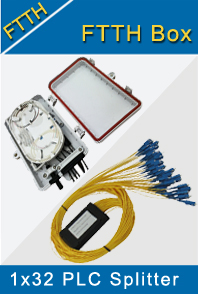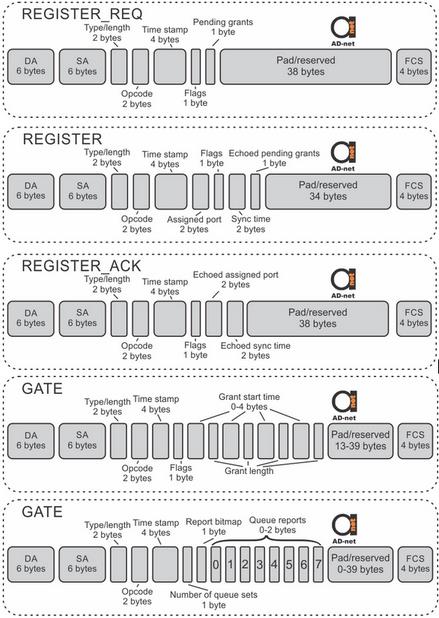-

- Sopto Home
-

- Special Topic
-

- FTTH Knowledge
-

- Medium Access Control in EPON communication between OLT and ONU
FTTH Knowledge
- Solving the FTTH Rollout Problem in Multiple Dwelling Units
- WDM PON Introduction FAQ
- A Simple Overview of Optical Power Meter
- ODN is based on PON FTTH Optical Cable Network of the Device
- Using an OTDR to be an Expert in Fiber Link Testing
- How FTTH Broadband Works?
- Connections among Fiber Terminal Boxes & Patch Cables & Pigtails
- Easy to Install a Fiber Terminal Box
- What is Arrayed Waveguide Grating?
SOPTO Special Topic
Certificate



Guarantee
Except products belongs to Bargain Shop section, all products are warranted by SOPTO only to purchasers for resale or for use in business or original equipment manufacturer, against defects in workmanship or materials under normal use (consumables, normal tear and wear excluded) for one year after date of purchase from SOPTO, unless otherwise stated...
Return Policies
Defective products will be accepted for exchange, at our discretion, within 14 days from receipt. Buyer might be requested to return the defective products to SOPTO for verification or authorized service location, as SOPTO designated, shipping costs prepaid. .....
Applications

Sopto supply the best FTTH solutions for your network!
SOPTO Products
- Fiber Optic Transceiver Module
- High Speed Cable
- Fiber Optical Cable
- Fiber Optical Patch Cords
- Splitter CWDM DWDM
- PON Solution
- FTTH Box ODF Closure
- PCI-E Network Card
- Network Cables
- Fiber Optical Adapter
- Fiber Optical Attenuator
- Fiber Media Converter
- PDH Multiplexers
- Protocol Converter
- Digital Video Multiplexer
- Fiber Optical Tools
- Compatible
Related Products
Performance Feature
FTTH Knowledge
Recommended

Medium Access Control in EPON communication between OLT and ONU
EPON is using different technologies for transmitting data downstream and upstream, due to its asymmetric P2MP architecture. Downstream signal is broadcasting encrypted data to all ONUs/ONTs, but ONUs/ONTs just can pick-up data intended for them. Security measure ensures that ONU/ONT cannot decrypt data intended for different ONU/ONT. It is possible, however, to use multicast addressing in downstream direction of EPON for video broadcasting or other media.
Upstream transmission is common for all the ONUs/ONTs in the network. In order to avoid data collision in that single channel, each ONU/ONT has its own time slot when data can be sent without interference from other network participants. Efficient control mechanism for upstream data is called MPCP (Multi-Point Control Protocol) and is using MAC (Medium Access Control) control mechanism.
MPCP is a frame based protocol using five MAC control messages shown in detail in Figure 1. Control messages are:
-
REGISTER_REQ
-
REGISTER
-
REGISTER_ACK
-
GATE
-
REPORT
Each of the messages is having its’ unique purpose in communication between ONT/ONU and OLT.

Figure 1. MPCP Frame Protocol
The REGISTER_REQ message is generated by ONU/ONT and sent to OLT for registration or deregistration. It is 64-byte Ethernet frame with message in the Opcode field, flag that identifies type of request and number of grants that ONU/ONT can buffer in the pending grant field.
The OLT is replying with REGISTER message. ONU/ONT is replying with the same parameters in REGISTER_ACK, providing OLT with knowledge that parameters are acknowledged.
Bandwidth is assigned using GATE and REPORT messages. GATE messages are broadcasted downstream from OLT carrying information about upstream bandwidth allocations. One GATE message carries up to four grants for ONUs/ONTs. ONU/ONT replies with REPORT message carrying up to eight queue statuses.

Another use of the GATE message - is the discovery of new ONUs/ONTs in the network. OLT periodically transmits discovery GATE message downstream, carrying information about Discovery Time Window. If new ONU/ONT receives this message, it replies during Discovery Time Window with the REGISTER_REQ message containing its unique MAC address. After OLT registered new ONU/ONT, it replies with REGISTER message waiting for REGISTER_ACK reply so the registration would be complete. GATE message is sent together with REGISTER message to define ONUs/ONTs answer time slot. Example of that is shown in Figure 2.

Figure 2. Registration of an ONU/ONT in discovery process
The MPCP is using REPORT/GATE mechanism for dynamical assignment of upstream bandwidth. Depending on the incoming traffic load and QoS requirements OLT changes upstream bandwidth allocation. Figure 3 shows the bandwidth negotiation between OLT and ONU/ONT. It is done in three steps:
1. First, ONU/ONT sends REPORT message with timestamp and queue status;
2. Then OLT is calculating RTT (Round Trip Time) based on timestamp and sending GATE message with TS, grant start time, and grant length;
3. Finally the ONU updates the local time based on TS and transmits data in the time slot.

Figure 3 bandwidth negotiation between OLT and ONU/ONT
Since the EPON is constantly updating technology and capacity is increasing, there is concern of growing energy consumption. Some devices are partially solving this problem by implementing sleep modes for the network equipment, which will only work full power in the need of high-speed communication. It is mainly done for ONUs/ONTs that are in the “asleep but aware” state, waiting to “wake up” anytime.
For more info, please browse our website. For purchasing fiber optic assembly products, please contact a Sopto representative by calling 86-755-36946668, or by sending an email to info@sopto.com.



